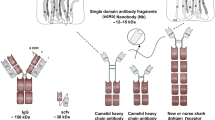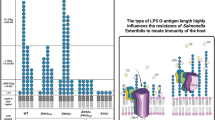Abstract
Newborn and 15-day-old rabbits were immunized with different doses of heat-inactivated suspension ofEscherichia coli andSalmonella paralyphi B. The secondary immunization was performed after 4 weeks and the dynamics, magnitude and site of the secondary response studied. The magnitude of the secondary response was found to depend on the magnitude and rate of the primary response, this latter reflecting the dose used. A direct relationship was found in the range of the minimal and optimal dose: the higher the primary dose the higher the secondary response. After a rapid and pronounced primary response evoked by a high dose of 1010 microorganisms in 15-day-old rabbits, a partial inhibition of the secondary response was observed. The inhibition was pronounced primarily in the spleen; the lymphatic nodes reacted by a higher number of antibody producing cells as compared with the control nonprimed young rabbits.
Similar content being viewed by others
References
Bauer, H. C., Mathies, M. J., Stavitsky, A. B.:Sequence of synthesis of beta 1 macroglobulin and gammaglobulin antibodies during primary and secondary response to protein, salmonella antigens and phage. J. exptl. Med. 117: 889, 1963.
Bellanti, J. A., Eitzman, D. V., Robbins, J. B., Smith, R. T.:The development of the immune response to Salmonella flagellar antigens in the newborn rabbit. J. exptl. Med. 117: 479, 1963.
Burnet, F. M., Stone, J. D., Edney, M.:The failure of antibody production in the chick embryo. Australian J. exptl. Biol. Med. Sci. 28: 291, 1950.
Buxton, A.:Antibody production in avian embryos and young chicks. J. gen. Microbiol. 10: 398, 1954.
Dresser, D. W., Mitchison, N. A.:The mechanism of immunological paralysis. Adv. Immunol. 8: 129, 1968.
Friedman, H., Gaby, W. L.:Immunological unresponsiveness to Shigella antigens in chickens. J. Immunol. 84: 441, 1960.
Gowland, G., Hobbs, G., Byers, H. D.:Attempts to suppress agglutinin production to a bacterial antigen (Pseudomonas Sp.) in the neonatal rabbit. J. pathol. Bacteriol. 90: 443, 1965.
Gowland, G., Oakley, C. L.:Acquired immunological tolerance of diphtheria alum precipitated toxoid in the domestic fowl. J. pathol. Bacteriol. 90: 373, 1960.
Hall, J. G., Morris, B., Moreno, G. D., Bessis, M. C.:The ultrastructure and function of the cells in lymph following antigenic stimulation. J. exptl. Med. 125: 91, 1967.
Halliday, W. J., Webb, M.:Secondary antibody response of mice to bacterial somatic antigens. Experientia 23: 488, 1967.
Henry, C., Jerne, N. K.:Competition of 19S and 7S antigen receptors in the regulation of the primary immune response. J. exptl. Med. 128: 133, 1968.
Landy, M., Sanderson, R. P., Jackson, A. L.:Humoral and cellular aspects of the immune response to the somatic antigen of Salmonella enteritidis. J. exptl. Med. 122: 183, 1965.
Medlín, J.:Formation of antibodies against bacterial polysaccharides by peripheral leukocytes. Fol. microbiol. 12: 562, 1967.
Medlín, J., Tlaskalová, H., Šterzl, J.:The primary and secondary response to the somatic antigen of gramnegative bacteria. W. Z. Friedr. Schiller Univ. Jena, Math-Naturw. 17: 124, 1968.
Medlín, J., Říha, I., Šterzl, J.:The antibody response preceding immunological aralysis. Fol. Biologica (Praha) 15: 309, 1969.
Mitchison, N. A.:Induction of immunological paralysis in two zones of dosage. Proc. roy. Soc. B 161: 275, 1964.
Nossal, G. J. V., Ada, G. L., Austin, C. M.:Antigens in immunity. X. Induction of immunological tolerance to Salmonella Adelaide flagellin. J. Immunol. 95: 665, 1965.
Solomon, J. B.:Immunity to Salmonella galinarum during ontogeny of the chicken. II. Induction of tolerance or priming by single doses of lived or killed bacteria. Immunology 15: 2, 1968.
Smith, R. T.:Immunological tolerance of non-living antigens. Adv. Immunol. 1: 67, 1961.
Smith, R. T., Bridges, R. A.:Immunological unresponsiveness in rabbits produced by neonatal injection of defined antigens. J. exptl. Med. 108: 227, 1958.
Svehag, S. E., Mandel, B.:The formation and properties of poliovirus neutralizing antibody. II. 19S and 7S antibody formation: differences in antigen dose requirement for sustained synthesis, anamnesis and sensitivity to X irradiation. J. exptl. Med. 119: 21, 1964.
Šterzl, J.:Immunological tolerance as the result of terminal differentiation of immunologically competent cells. Nature 209: 416, 1966.
Šterzl, J., Silverstein, A. M.:Developmental aspects of immunity. Adv. Immunol. 6: 337, 1967.
Šterzl, J., Trnka, Z.:Effect of very large doses of bacterial antigen on antibody production in newborn rabbits. Nature 179: 918, 1957.
Uhr, J., Finkelstein, M. S.:Antibody formation. IV. Formation of rapidly and slowly sedimenting antibodies and immunological memory to bacteriophage ΦX 174. J. exptl. Med. 117: 457, 1963.
Tlaskalová, H., Medlín, J., Šterzl, J.:Ontogenetic development of antibody formation in response to different doses of gram-negative microorganisms in young rabbits. I. Dynamic and site of antibody formation after primary immunization. Fol. microbiol. 14: 578, 1969.
Wigzell, H.:The rise and fall of 19S immunological memory against sheep red cells in the mouse. Ann. Med. exp. Fenn. 14: 209, 1966.
Wigzell, H.:Studies on the regulation of antibody synthesis. Cold Spring Harbour Symp. Quant. Biol. 32: 507, 1967.
Author information
Authors and Affiliations
Additional information
Dedicated to Academician Ivan Málek on the occasion of his 60th birthday
Rights and permissions
About this article
Cite this article
Medlín, J., Tlaskalová, H. & Šterzl, J. Ontogenetic development of antibody formation in response to different doses of gram-negative microorganisms in young rabbits. Folia Microbiol 14, 588–594 (1969). https://doi.org/10.1007/BF02884173
Received:
Issue Date:
DOI: https://doi.org/10.1007/BF02884173




